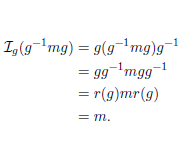The Notions of Center, Commutator and Inner Isomorphism for Groupoids
Main Article Content
Keywords
Groupoid, normal subgroupoid, normalizer, center, commutator, inner isomorphisms
Abstract
In this paper we introduce some algebraic properties of subgroupoids and normal subgroupoids. we define other things, we define the normalizer of a wide subgroupoid H of a groupoid G and show that, as in the case of groups, this normalizer is the greatest wide subgroupoid of G in which H is normal. Furthermore, we provide definitions of the center Z(G) and the commutator G' of the groupoid G and prove that both of them are normal subgroupoids. We give the notions of inner and partial isomorphism of G and show that the groupoid I(G) given by the set of all the inner isomorphisms of G is a normal subgroupoid of A(G), the set of all the partial isomorphisms of G. Moreover, we prove that I(G) is isomorphic to the quotient groupoid G/Z(G), which extends to groupoids the corresponding well-known result for groups.
Downloads
References
[1] H. Brandt, “Über eine verallgemeinerung des gruppenbegriffes,” Math. Ann, vol. 96, pp. 360–366, 1926.
[2] C. Ehresmann, OEuvres complètes et commentées, ser. Oeuvres complétes. Topologie algéBrique et géométrie différentielle, 1950, no. partes 1-2.
[3] R. Brown, “From groups to groupoids: a brief survey,” Bulletin of The London Mathematical Society - BULL LOND MATH SOC, vol. 19, pp. 113–134, 03 1987. https://doi.org/10.1112/blms/19.2.113
[4] A. Ibort and M. Rodríguez, “On the structure of finite groupoids and their representations,” Symmetry, vol. 11, p. 414, 03 2019. https://doi.org/10.3390/sym11030414
[5] G. Ivan, “Strong morphisms of groupoids,” Balk. J. Geom. Appl., vol. 1, no. 4, pp. 91–102, 1999. https://www.emis.de/journals/BJGA/v04n1/B04-1-IVAN.pdf
[6] G. Ivan, “Algebraic constructions of brandt groupoids,” pp. 69–90, 01 2002.
[7] S. Zakrzewski, “Quantum and classical pseudogroups. ii. differential and symplectic pseudogroups,” Comm. Math. Phys., vol. 134, no. 2, pp. 371–395, 1990. https://projecteuclid.org:443/euclid.cmp/1104201735
[8] P. Stachura, “Short and biased introduction to groupoids,” J. Knot Theor. Ramif., vol. 27, no. 7, pp. 1–13, 2018. https://arxiv.org/pdf/1311.3866.pdf
[9] M. Lawson, Inverse Semigroups: The Theory of Partial Symmetries. World Scientific, 1998. https://books.google.com.co/books?id=2805q4tFiCkC
[10] A. Paques and T. Tamusiunas, “The galois correspondence theorem for groupoid actions,” Journal of Algebra, vol. 509, pp. 105 – 123, 2018. https://doi.org/10.1016/j.jalgebra.2018.04.034
[11] J. Ávila, V. Marín, and H. Pinedo, “Isomorphism theorems for groupoids and some applications,” Int. J. Math. Math. Sci., vol. 2020, no. 3967368, pp. 1–10, 2020. https//doi.org/10.1155/2020/3967368
[12] B. Bainson and N. D. Gilbert, “The homology of principally directed ordered groupoids,” Homology Homotopy Appl., vol. 22, no. 1, pp. 1–9, 2019. https://arxiv.org/pdf/1704.03689v1.pdf
[13] H. Myrnouri and M. Amini, “Decomposable abelian groupoids,” Int. Math. Forum, vol. 5, no. 48, pp. 2371–2380, 2010.
[14] D. S. Dummit and R. M. Foote, Abstract Algebra, 3rd ed. New Delhi: Wiley, june 2003.

